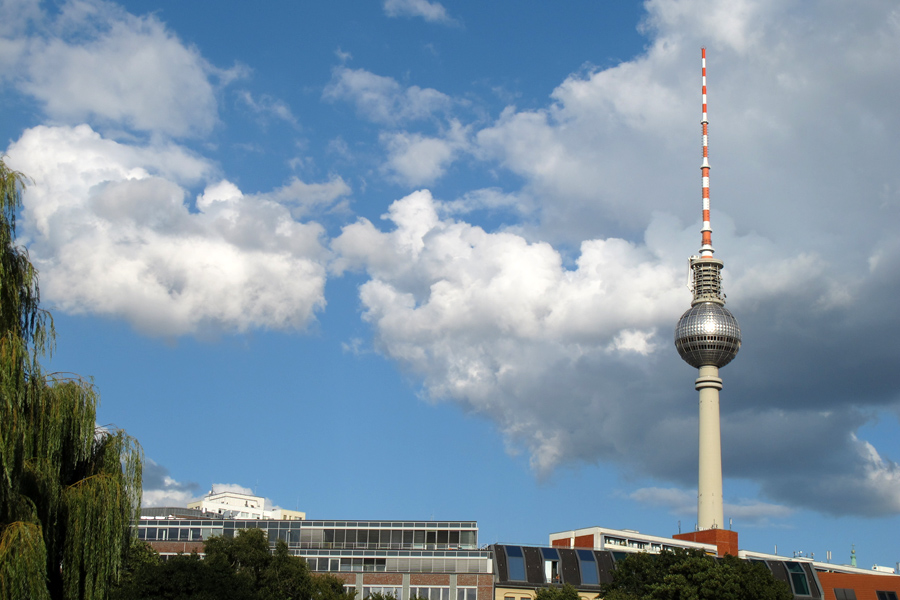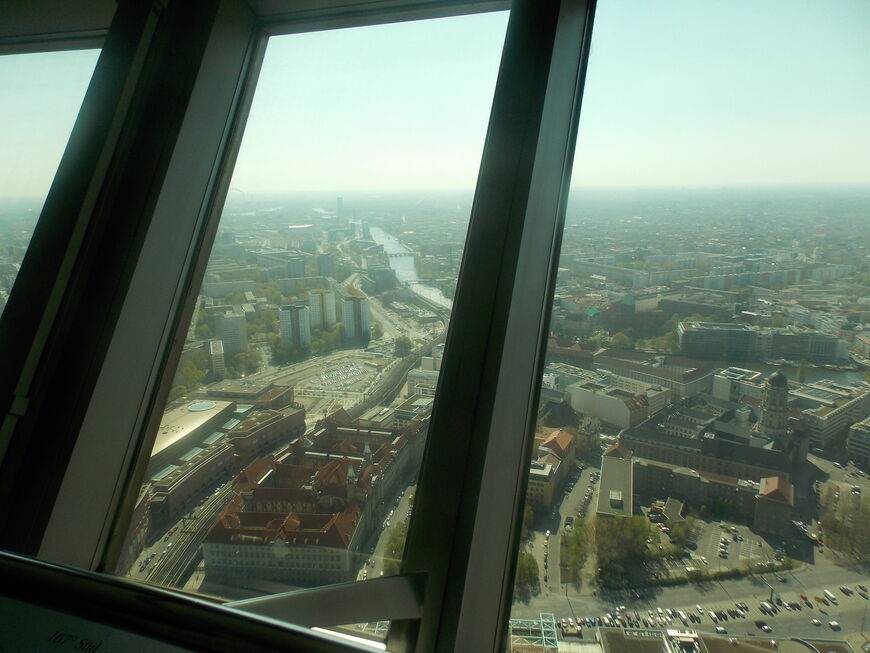Berlin TV Tower (Berliner Fernsehturm)

Since 1969, it has topped the list of Germany's tallest buildings. Its height is 368 metres. The television tower is located in the centre of Berlin on Alexanderplatz and dominates the city. Along with the Reichstag (Reichstagsgebäude) and the Brandenburg Gate (Brandenburger Tor), it is Berlin's most important landmark. In early film scenes related to Berlin, the German capital is often symbolised by the TV Tower in addition to buildings such as the Brandenburg Gate, the Victory Column (Siegessäule) and the Reichstag building.
View of the city
In just 40 seconds, a lift takes you to the observation deck where you can admire Berlin from above. The view from the Berlin TV Tower is particularly beautiful in the morning or evening, when the Spree sparkles in the sun. Directly below the TV Tower is the Mitte district with its historic city centre, which can be seen in detail.
The observation deck is 203 metres above the ground. There you can look at Berlin through slanting panes of glass. On a clear day, the telescope on the observation deck extends to the outskirts of the city and even beyond: you can see up to 70 kilometres (you can even see the Brandenburg wind turbines spinning). There is also a bar on the observation deck.

A special attraction is the restaurant on the floor above the observation deck. In it, the tables rotate 360 degrees along the circular window front. Depending on the speed set, guests can look out over the city in almost all directions. The restaurant is called "Sphere" (it used to be called "Telecafé").
History of construction
The international-style TV tower was built between 1965 and 1969 by the Deutsche Post GDR in a park on the site of the demolished Marienviertel quarter. The opening took place on 3 October 1969. The structure is over 220 metres taller than Berlin's old radio tower from the 1920s in the western part of the city. In addition to its main function as the site of several radio and television transmitters, the Berlin TV Tower is a venue for events.
Thanks to its universal and timeless design language, this building is increasingly being used as a trademark and is internationally identified with Berlin and Germany. The history of the TV tower dates back to the need for uninterrupted television and radio broadcasting in the GDR. At the European Broadcasting Conference in Stockholm in 1952, held to coordinate radio frequencies in Europe, only two frequencies were allocated for the GDR, which was then politically unrecognised by most states.
At that time, the GDR had only partial coverage, resulting in duplication, interference or even no TV coverage in some areas. In response to this problem, the Deutsche Post GDR soon began planning the construction of a television tower in Berlin. It was in the 1960s that the GDR government ordered the construction of a television tower, to demonstrate to the world the power and efficiency of the socialist system.
German architect Hermann Henselmann was appointed to design the TV tower. It was supposed to be built 8 kilometres away from the Schönefeld Airport (Flughafen Berlin-Schönefeld), but this would have affected the operation of the airport, so Alexanderplatz was chosen as the location. Foundation work started on 4 August 1965 and was completed by the end of 1965. Concreting of the basement of the TV tower started on 15 March 1966. There was only one possible way of constructing the TV tower — industrial climbing.
Mounting the sphere at a height of 200 metres gave the engineers a lot of headaches. First, the supporting steel frame was assembled on the ground. The segments were then lifted by cranes and attached to a ring-shaped platform that formed the end of the concrete core. The sphere of the Berlin TV tower was to resemble the Soviet "Sputnik" and glow red — the colour of socialism.
The inauguration of the Berlin TV Tower took place on 3 October 1969 — shortly before the GDR celebrated its 20th anniversary. For Walter Ernst Paul Ulbricht, the then head of state of the GDR, the iconic TV tower, erected in just four years, was proof of the superiority of communism. The structure, which was officially called the Berlin Television and VHF Tower, was the second tallest TV tower in the world in October 1969. Only the Ostankino TV tower in Moscow was higher. At the same time, it was the third tallest free-standing structure of its time after TV tower in Moscow and the Empire State Building in New York.
In 1979 the TV tower was designated a historic monument. This status remained even after the fall of the Berlin Wall and the dissolution of the GDR. After German reunification, the significance of the Berlin TV Tower changed completely: it went from being a symbol of the GDR to a symbol of the city and is now an international symbol of Berlin and Germany.
Interesting facts
The Berlin TV tower is Germany's tallest building (368 metres). It has grown a bit since a new antenna was installed in the 1990s. The observation deck is at a height of 203 metres, so on a clear day visitors can see the Brandenburg landscape. The antenna itself is 118 metres high.
The tower can vibrate. Despite the tried-and-tested system (a mass damper, a 1.5-tonne metal rod suspended on three cables, four hydraulic telescopic shock absorbers), the TV tower is subject to barely perceptible vibrations: at the tip of the antenna the movement can be up to 60 cm, on the sphere about 15 cm. The frequency of the vibrations is 7 to 10 seconds. According to safety regulations, up to 400 people can be inside the sphere at one time: 380 visitors and 20 employees.
To avoid emergencies and limit the risk of fire, the kitchen was built on the ground floor of the TV tower. All meals ordered in the restaurant are taken upstairs in a special lift. In addition, there are three lifts in the TV tower: two for visitors and one for staff. It takes just 40 seconds to reach 203 metres (the lift travels at 6 metres per second).
In October 2019, the TV Tower celebrated its 50th anniversary. Its construction began in 1965 and was completed in 1969. The East German government set a goal of completing the construction by 3 October 1969. Workers therefore worked in three shifts to speed up the process.
In 2007, a feature film disaster was made, "Raging Inferno" ("Das Inferno — Flammen über Berlin"), in which the Berlin TV tower is used as a burning backdrop. The film is informative, although it is not a cinematic masterpiece. In the film, while firefighters work to rescue people trapped in the TV tower, an engineer explains in detail exactly how the sphere of the tower is set up.
Address: Panoramastraße 1A, D-10178 Berlin.
Official website: https://tv-turm.de/
